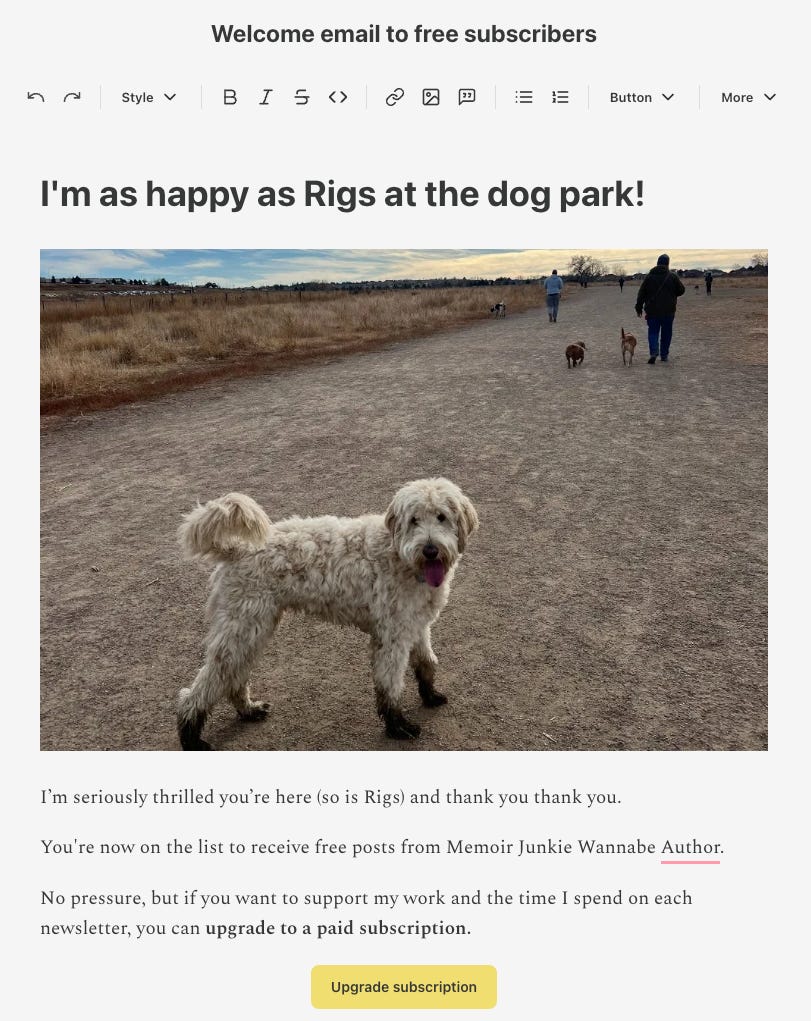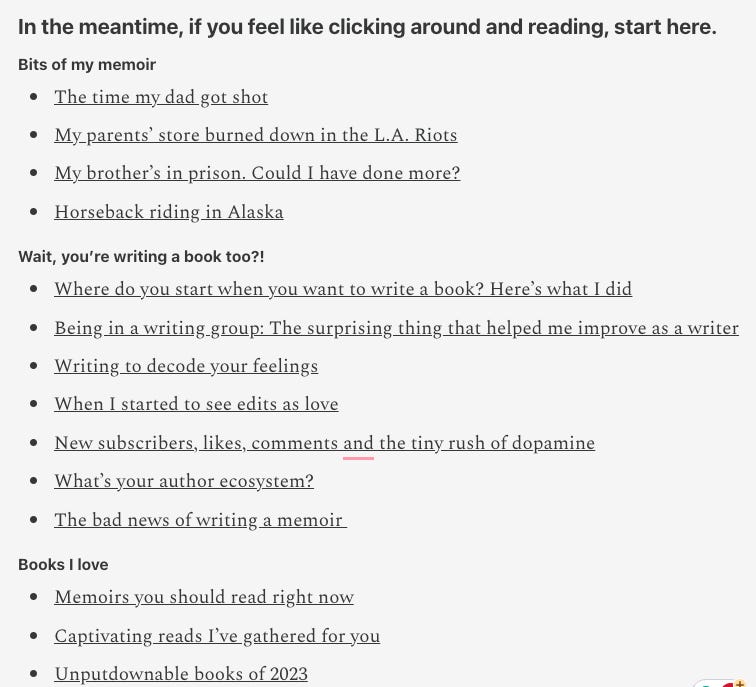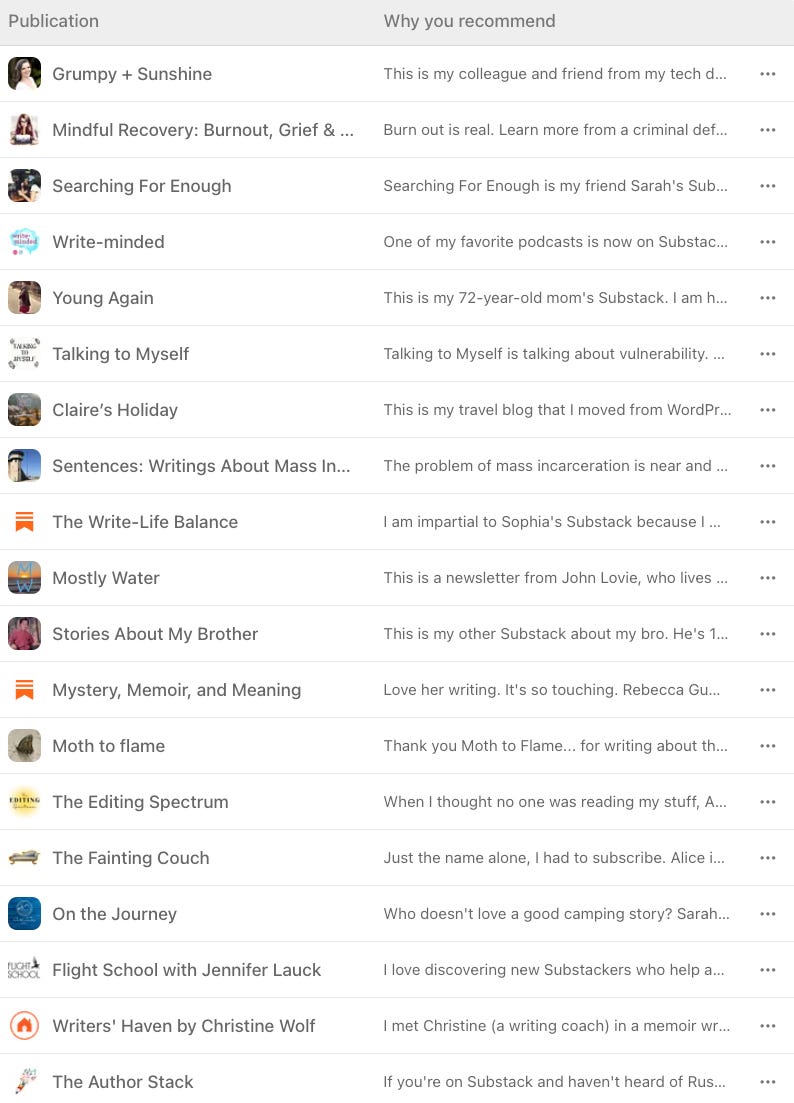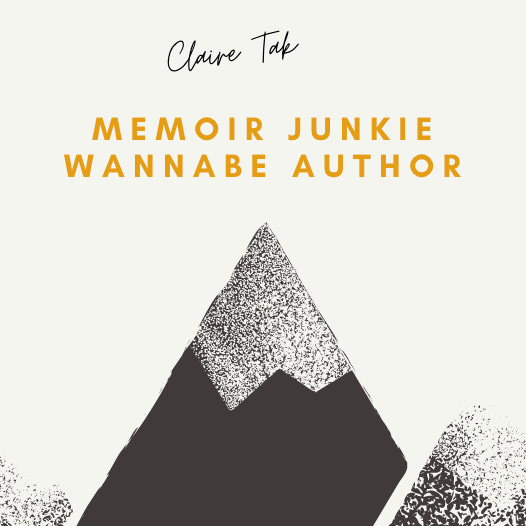Creating a sustainable Substack content plan that doesn’t take up a ton of time
You made some awesome content on Substack, now it's time to maximize.
Hi friends,
Thank you to everyone who commented on my last newsletters what I learned in my second year of Substack (part 1 covered creating sustainable growth and part 2 was about writing consistently without burning out).
Today’s newsletter is almost like a part three. Based on your comments and feedback, I wanted to expand on growing your Substack and creating more intention in your content strategy. If you’re intimidated by the term “content strategy,” don’t be. All it means is you have a plan for what you want to write, when to publish it, and how you share it.
I’ll discuss developing a content plan that doesn’t take up too much of your time. I’ll also share tips on a few important features within Substack for better showcasing your “brand” (AKA, you).
Quick note: These tips are meant for people who have already written a fair amount of content. Maybe you’ve posted every week for the last six months and need to rethink your strategy because you’re short on time. Or perhaps you’re ready to take a step back and assess how you can get smarter with your Substack newsletters (I have ideas for that too!).
I hope you find this advice helpful. If you have any questions or comments, don’t hesitate to leave them. Your comments help me decide what to write about next!
1. Figure out a posting schedule that works
When I first created Memoir Junkie Wannabe Author, I posted a newsletter every single week. My background in content marketing told me this was critical to getting people interested and on board. I aimed to post once a week.
For the first six months, I diligently published a weekly newsletter, posting on Tuesday at 5 a.m.
After six months, I took a step back to examine how I felt about this schedule. While I enjoyed it, figuring out what to write, writing, editing, and publishing took a lot of time. I started to feel burnt out and realized I was dreading the end of the week when I’d have to begin my next newsletter.
When I’m no longer excited about the process, I always stop and assess what’s going on. If you’re going, going, going but not gung-ho about the process, you may want to revisit your posting frequency.
While I loved posting and sharing on Substack, I knew a once-a-week publishing schedule would not be achievable in the long run.
I decided to slow it down. I reduced it to twice a month. At first, I didn’t notice a big drop-off in subscribers. I still saw a steady stream of engagement (mainly in the form of comments), but after a few months, I noticed the engagement kind of fell off. But the open rate and views were steady.
Then, there was a big lull when I saw no new subscribers. I realized I needed to use this “free time” I would have otherwise been spending on writing my weekly posts to start expanding my reach. I kept my eyes peeled for ways to contribute to other people’s publications, including this opportunity to become a guest contributor for The Author Stack.
I had previously connected with Russell on Zoom and written about The Author Ecosystem on my Substack, so the decision to contribute to his publication felt natural. (A big tip for growing your Substack is connecting with others on the platform.)
By shifting my time and schedule, I expanded my reach and gained a steady flow of subscribers.
Take a step back and assess your posting schedule. If you dread sitting down to write, see what changes you can implement. Maybe you can try twice a month and evaluate the numbers afterward to see if engagement has dropped significantly. Or maybe you can create shorter posts but still maintain the weekly schedule.
The key is to be consistent.
2. Publish and share other people’s stories
A big part of the Substack experience is forming connections with other writers. I observed what other Substack authors were doing with their content. They asked their community to contribute to their Substack as guest authors.
There are many reasons to do this, including wanting to expand your reach (i.e. if I contribute to another publication, I will likely share that newsletter with my followers, too), build connections, or position your Substack as a collaborative publication. I decided to do the same.
Here are a few published stories from my writer community:
I put the word out and published other writers’ stories. Because I was involved in writing classes, finding writers who wanted their stories shared wasn't hard. If you don’t have writing colleagues, connect with others on Substack by subscribing and commenting or getting on Notes.
See if you can contact your Substack “friends” and collaborate or cross-promote. What I love most about Substack is how involved everyone is with their audience!
Here’s a quick tip on how to connect with other Substackers:
Follow newsletters you enjoy and comment on posts you like.
Share them on Notes.
Be thoughtful of what you say.
Rather than writing, “Thanks for sharing,” say what resonated with you, or ask a question to elicit a response.
Create a page on your site that lets readers know they can contact you if they want to contribute. To be more efficient in creating a process for growing this, you could create an intake form on Google Forms and paste a link.
When my readers saw I was publishing other people’s stories, they contacted me and asked if they could share theirs. Ramping this up takes time and intention, so be patient.
While posting and sharing other people’s pieces is a great way to grow engagement, preparing them for publishing still takes time and effort. I had to edit and ask questions about the parts that felt unclear.
3. Assess your content
Now that I’m in year two of Substack, I have a good deal of content and have organized my site better. (Read part 2 to learn more about your site organization.)
I regularly check my dashboard in Substack to analyze what got the most views, opens, likes, and comments. I love seeing these numbers grow! I was floored the day I saw my views broke 1,000.
See what gets the most engagement and note to write more newsletters that expand on those topics.
The newsletters that typically get the best engagement are stories where I share something that:
Is highly vulnerable
Is about writing tips and craft
Provides insight on how I continue growing my Substack
Here are my top stories from 2023-2024:
Embezzlement, betrayal, and federal prison: This was a story from my writing buddy. I never thought a guest post from someone else would get engagement like this!
The bad news of writing a memoir: I feel like this topic resonated with people because honestly, why do people write books when it’s such an uphill battle?!
Unputdownable books of 2023: I’m a huge audiobook person, so I enjoy sharing my top reads every quarter or so. While these newsletters take time to write, they also get many views because they generally appeal to everyone.
This leads to my next quick tip: I start drafts ahead of time for stories that take me a while to write. So, for the best books list, I’ll sometimes get ahead by writing notes about them while listening to the book.
Another tactic to reduce the time I spend on these posts is to reduce the word count for each book to a few sentences (brevity is a challenge for me!).
Writing a little at a time for more time-intensive stories helps reduce the feelings of overwhelm and resistance.
4. Create roundups
When done with intention, roundups can actually be a great way to quickly reshare what you’ve written about and get them in front of your newer readers.
You can also commit to roundups where the entire newsletter is dedicated to your favorite Substacks. I want to get more consistent at doing these, but here is one that got me a few subscribers!
I follow other Substackers who share roundup posts regularly and then post them on Notes.
Here are thoughtful ways to do your roundups:
Collect newsletters based on themes or umbrella topics. For example, I could organize a roundup of the best writing tips or newsletters about writing regularly.
Include other people’s Substack posts (that have the same theme or amplify your message) in your roundups. Be sure to tag them so they see it and potentially share it.
Do a “most popular” or “trending” roundup, based on top newsletters for the week, month, quarter, or year.
Quick side-tip: Create an Excel sheet with a running list of your published URLs broken down by topic. Then, you can quickly reference them to copy and paste them into roundups or updates. Trust me, this helps save time!
5. Update older posts you’ve written
When you post on the internet, it’s instantly dated. Updating your older stories keeps them fresh and saves time when writing new ones. It’s another great way to get your stuff in front of your newer subscribers.
Examine your newsletters and consider refreshing stories that:
Got the most views
Have a ton of comments
Offer your best tips/advice/stories
For example, I could do updates for my posts about joining writing groups and what I’ve learned since I first signed up two years ago.
For updates, it’s not about rewriting the whole thing. It can be as fast as inserting a paragraph at the top in italics about what’s changed since you wrote this piece and why.
6. Use Notes more often
I need to take my advice on this, as I don’t use Notes nearly as much as I want. 😆
But here’s why Notes is awesome–consider it an extension of your Substack. Whenever you don’t have time to write a whole post, get on Notes and share your insights of the day or something that resonated with you.
Other tips for Notes:
Share older newsletters on Notes with a sentence or two about why you’re sharing them.
Comment and like other people’s Notes–it’s a fantastic tool for engagement and connection.
Restack other Substacks on Notes with a thoughtful comment explaining why.
Substack tips
While having a content plan matters, so do the “little things” on Substack that can help with growth and engagement.
7. Turn on your paid subscription
It took me an entire year before I felt like I was worthy of turning on Substack’s paid subscription for Memoir Junkie Wannabe Author. In one particular Substack Office Hours (no longer offered on Substack), someone told me to turn on your paid option, no matter what. Don’t think about it, just turn it on because you never know who will want to become a paid subscriber.
I don’t know why it took that kind of encouragement, but I’m glad that person told me to just go for it. I expected nothing, but I have a handful of paid subscribers today. OK, to be fair, a few of them are my friends, but their support still counts and means so much to me!
3 Tactics for your paid messaging
“My content is always free, but you can still pay.”
My favorite Substack authors tell their readers that their content is always free, but “I appreciate your donation to support my work because it’ll help pay for the time I spend writing and providing great content.”
I appreciate this kind of messaging because it tells readers that their work is quality but free no matter what, and they always have the option to donate and become paid followers.
“I’m about to turn on the paid option on my Substack, and I’m scared.”
Another type of messaging I like is when Substack authors are transparent about every step of the paid subscription process. One woman I follow said she was terrified to turn this on and felt like a fraud, because, who would want to pay?! She also admitted she didn’t have a full strategy for what content she would share with paid vs. free members. She asked her readers to be patient, and guess what? They were super patient and supportive.
“Here’s what you get when you become a paid subscriber.”
Then there’s the strategic Substackers with a solid plan for engaging their paid subscribers. For their paid member, they give them access to things like:
Exclusive group chats and Q&As
Premium content (one gal who reviewed books had a “cliff notes” section of her site that was locked content and only accessible through paid)
The best tips, such as guides or how-tos
Or maybe you don’t do any of the above and quietly turn start including the “paid” buttons in your newsletters. That’s fine, too!
8. Three ways to improve your branding on Substack
Welcome email
How to get to your welcome page: Go to your Dashboard >> Settings >> [left rail] Branding >> Welcome email
If you still use the generic Substack welcome email, make it your own. Tell readers why you’re grateful to have them and what they can expect with your content.
Alas, this also took me a while to revisit and revamp, but after I did it, I felt so much better about giving my new subscribers valuable content.
My welcome email points people to various parts of my site with links to the most popular and evergreen content, such as writing tips and recommendations for books and podcasts.
Now that I have a handful of paid subscribers, I’ve created two versions that differentiate paid from free. Honestly, the links are pretty much the same in both versions; the only thing that’s different is the messaging.
In the paid version, I thank people profusely because it’s a dream of mine to get paid for my work on Substack (and one day grow it to the point where I can make a living from it)!
Your About page
How to get to your About page: Go to your Dashboard >> Settings >> [left rail] Basics >> About page
This is another opportunity to include links to your content. Like your welcome page, think about the most valuable, evergreen content the reader has likely come to your site for. But the About page should show you’re a human.
Add photos, favorite books, other Substacks you enjoy, or what you like to do in your free time.
Recommendation blurbs
How to get to your About page: Go to your Dashboard >> [top tabs] Recommendations >> [at the top] click Manage
In my previous Lessons in Substack Year 2 post, I discussed setting up recommendations (scroll down to tip #4) to share other people’s Substacks. Just like turning on the paid subscription, just do it.
I forgot to mention in the previous parts 1 & 2 newsletters that I spent time writing a unique blurb about why I recommend them. Sometimes I take a sentence or two from their “About me” page and tweak it to make it my own.
The most important thing to convey is why I’m recommending them, what do I like or enjoy about their Substack? Chances are, this is what other people will enjoy as well. Adding that tiny personal touch makes a big difference in getting folks to subscribe to them.
So, that’s it for now. I hope you will implement some of these tips to help grow your readership without taking too much time. If you’re like me, you already probably spend a great deal of your day in front of screens. While I love Substack, I also love being outside, seeing friends, and traveling. 😁
Tip: Be sure to check out Russell’s in-depth guide on mastering your content calendar.
If you found this newsletter helpful, I would love it if you could leave me a comment below. Or if you didn’t find it useful, tell me why! I would be happy to go deeper on anything I’ve written about in this newsletter, or if you’re interested in learning more about content strategy, feel free to let me know.
What do you think of this one?
Does it give you ideas on how to expand your own content on Substack?
Have you ever done a refresh of your publication?
Let us know in the comments.
If you saw value here, I hope you’ll consider becoming a paid member to help foster more of this type of thing. As a member, you’ll get access to over 650 exclusive posts, including books, courses, lessons, lectures, fiction books, and more, or you can give us a one-time tip to show your support.

















I've seen roundups come to my in-box, but I never considered doing them myself until reading your section about them. I think I'll find a different subject for each roundup -- mine and other site's writing about a particular theme. Someone else told me to invite guest authors, so I hope to build enough relationship with people who write about my topic to get that started, too. Thanks for the ideas and for sharing your "experience, strength, and hope."
As a published writer half of a team writing here on Substack on Grief - Grief 101 - I found a lot of h elpful tips and ideas in this newsletter that I'm going to follow up on. Thanks, Russell.